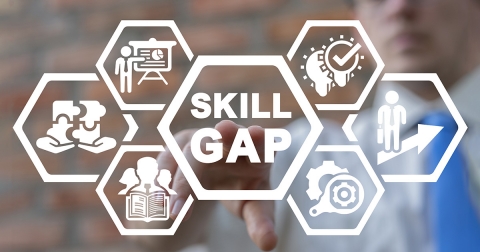6 Ways to Bridge the Gap Between Schools and Industry When Designing CTE Programs
Staying connected to your local industry is an excellent way to make sure you are designing CTE programs that are attractive to students and useful to the local community. Here are 6 things to consider when you're bridging the gap between your school programming and the workforce.
1. Consider Type of Career and Technical Education
Identify the fastest-growing industrial sectors in your region and tailor appropriate CTE programs. Make sure to pay attention to future-proofing your knowledge base as much as possible, accounting for estimates that, according to McKinsey.com, around 30% of activities in the global workforce are technically automatable. In addition look at statewide government spending trends and promises. Something else to consider; the length and frequency of the courses you want to offer. For example; Amatrol's Ignite program can run as long as 3 years with a progression across skillsets, including; mechatronics systems, advanced manufacturing, system design and data analysis, electronics. Alternatively, Amatrol's Industry 4.0 Fundamentals covers: mechatronics, industrial control systems, robotics, introduction to the IIoT, and production technician certification. The I4F portfolio can be selected a la carte featuring SACA certification awarded accordingly. Other certification standards, such as MSSC can be achieved over various timeframes with similar equipment and courseware.
2. Understand That Resources Are Necessary For A Successful CTE Program.
- Students and educators require access to computers and the internet in order to make use of eLearning programs.
- Hands-on training is a hugely beneficial form of educating students. In addition, large trainers visible from outside the classroom can make your courses more attractive to prospective students. Be aware of the requisite space and access to requirements (Electricity/Water/Air etc.) that simulators need.
3. Keep Class Size in Mind for Optimal CTE Training.
Keeping class sizes to a minimum is the goal for most educators. You can attract large numbers of students with flexible, project-based, in-person learning, combined with easily accessible interactive eLearning. With a combination of learning styles, students can be guided through the syllabus without crowding the classrooms.
4. Be Aware Of Available Funding for CTE and STEM Programs.
Staying in touch with local industry and municipal agencies is a great way to stay abreast of the kind of grant assistance that is available locally. This website lists some fantastic national grants that can be applied for; your local area may provide more.
5. Plan The Marketing Of Your CTE Program
“Preparing You for a Career Without a Mountain of Student Debt”.
You're most of the way there to a successful CTE program, now you need to fill the classroom with students; marketing is a hugely important way to increase your enrollment. Amatrol and our distributors can help you get the right information into students' and parents' hands, with flyers and landing pages that explain the scope and powerful relevance of the courses you will offer. It's important to connect the education that you are offering with its real-world application. Think also about your hallway appeal, prospective students will be fascinated by the hands-on learning tools that are on display in your classroom, especially if you can explain the connection between your department's simulators and local industry. Take care to explain your department's remit to the school's guidance counselors so that they understand what you are offering students. Otherwise, be prepared to hear your class being referred to as “shop class.” Counselors need the correct terminology, available job information, and expected wages so that they can create an accurate narrative for prospective students. If you aren't on the same page, it's going to be that much harder to get students into your program. Recruit in non-traditional places like the gym and invite students for tours of your facility in combination with local industry field trips.
6. Be the Change: Become a Liaison Between Industry and Schools to Build Better CTE Programs.
Become a node for larger conversations between local Industry and High Schools / Colleges. By opening up dialogue, you increase the likelihood of success for your CTE programs, consider visiting local industries and determine their needs. Show them what you are currently doing, and ask for their advice on how to make it better. Better yet, ask that Industry sends someone to your school to validate that your course is teaching the skills they desperately need. Reach out to high schools, colleges, and technical schools with which you could potentially share resources and create a successful pipeline from high school through to the workplace.
Most companies would be happy to work with schools, especially if it could lead to a potential hiring pipeline in the future.
How X-Cal Can Help Build Successful CTE Programs
Please reach out to us, we can help you figure out the best ways to serve your students and put you in touch with our local representatives to assist you in building the perfect CTE programs for your region.
If you need help developing a program contact the experts at Amatrol. With more than 30 years of experience creating quality eLearning curriculum, Amatrol remains the world's leader in skills-based interactive technical learning.
Products that can help you build a great CTE lab include:
Interactive eLearning Curriculum
Focusing on in-depth industrial knowledge and hands-on technical skills, Amatrol's highly-interactive multimedia eLearning curriculum appeals to learners with different learning styles. Our extensive eLearning library features hundreds of courses offering thousands of hours of technical training for a vast array of subject areas.
Amatrol's eLearning courses are self-directed and available online 24/7. Each course features a modular design that breaks down major topics into manageable segments, each with its own series of objectives, activities, skills, and self-reviews. This format gives learners the flexibility to set their own learning pace.
Virtual Training Systems
Amatrol's eLearning is unique in its focus on teaching relevant hands-on skills using real industrial equipment like students will encounter on the job. With social distancing measures in place, it can be difficult to maintain this part of the curriculum, but it's possible with Amatrol's eLearning.
For example, Amatrol offers a variety of virtual trainers that simulate actual equipment, allowing students to replicate hands-on skills as if they were using real equipment. Virtual trainers are available for a variety of technical areas, including electrical, electronics, fluid power, machining, manufacturing processes, mechanical, and quality assurance.
Training Systems
- Talk about how our systems begin with foundational industry technology like electrical wiring, piping, hydraulic and pneumatic power, and mechanical drives, and build to complex topics like robot programming, PLC programming, and process control, as well as HVAC/R and Green Energy systems.
- Mention that these are built using heavy-duty, welded steel frames and feature real-world industrial components so the systems will stand up to frequent use and mimic real industrial processes.
Turnkey CTE Programs from Amatrol
- IGNITE: expand on what you said above about IGNITE. Use the spread in the Amatrol catalog for talking points. Definitely mention that it was developed with funding from the US Department of Defense to help strengthen the domestic supply chain among American manufacturers
- I4F: expand on what you said before. Use the spread in the Amatrol catalog for talking points.





